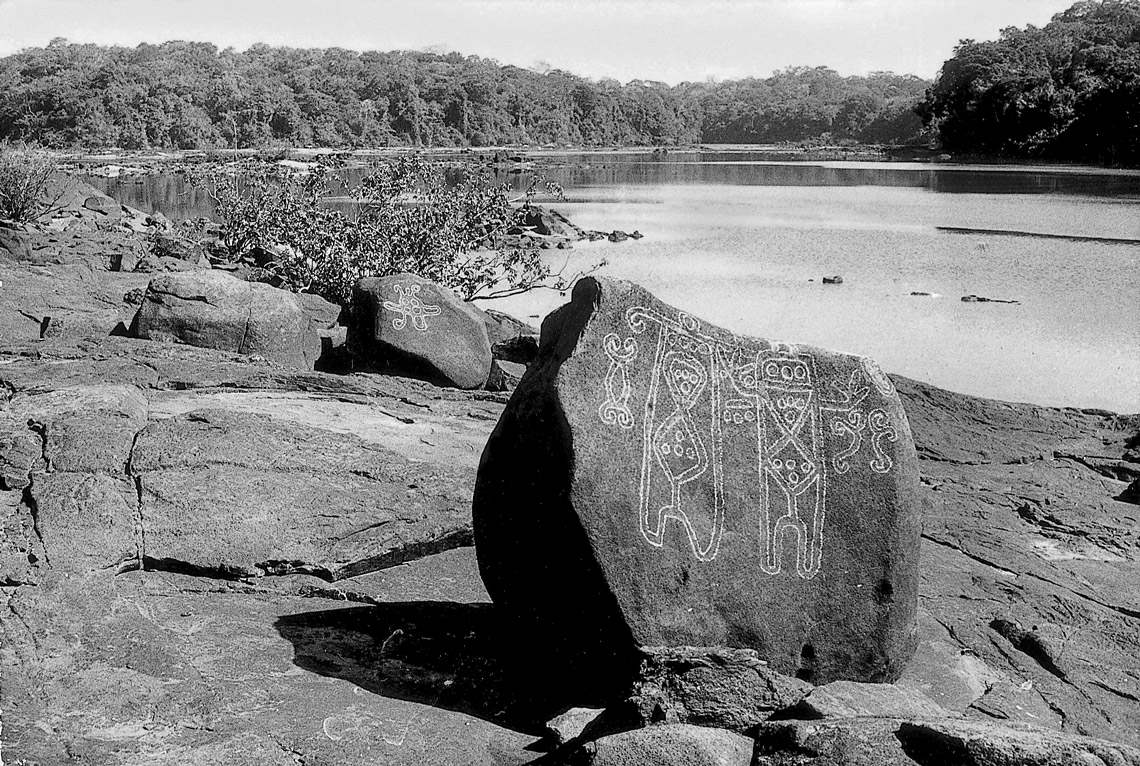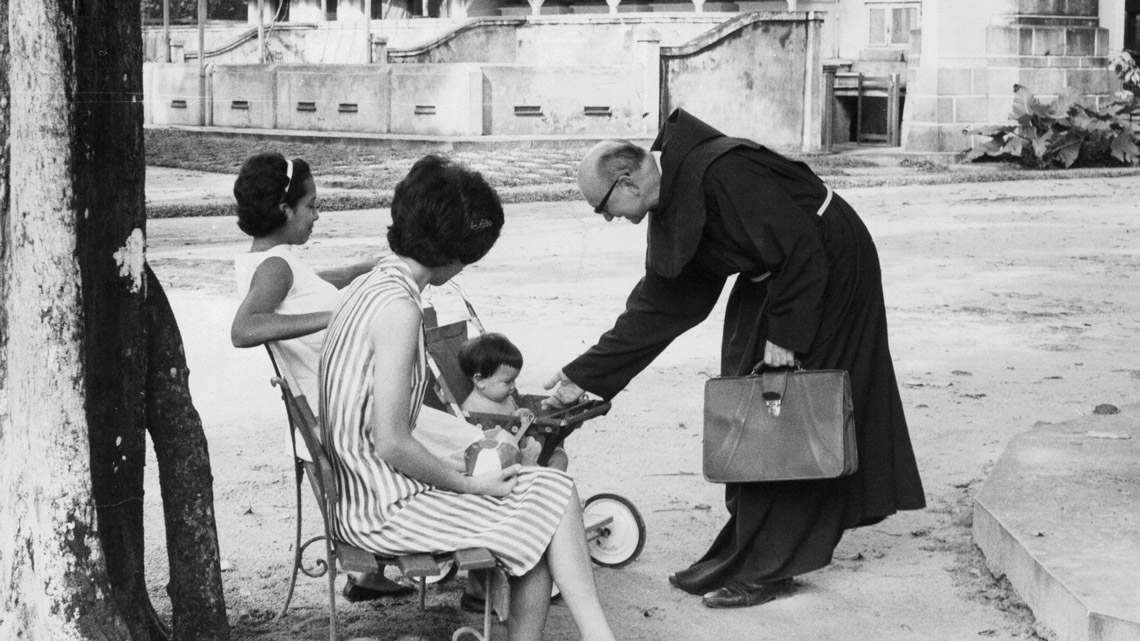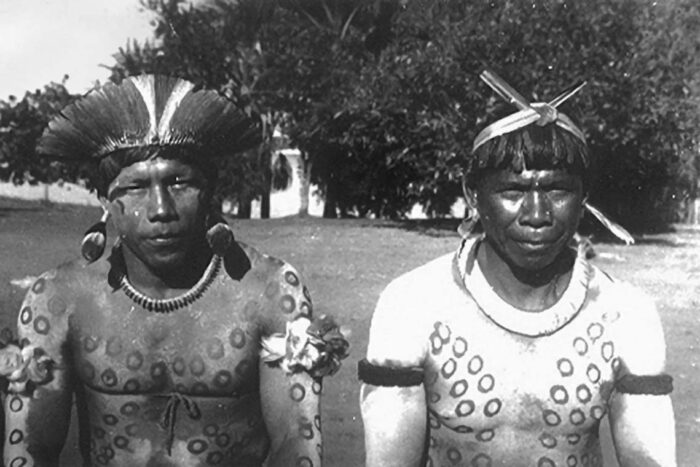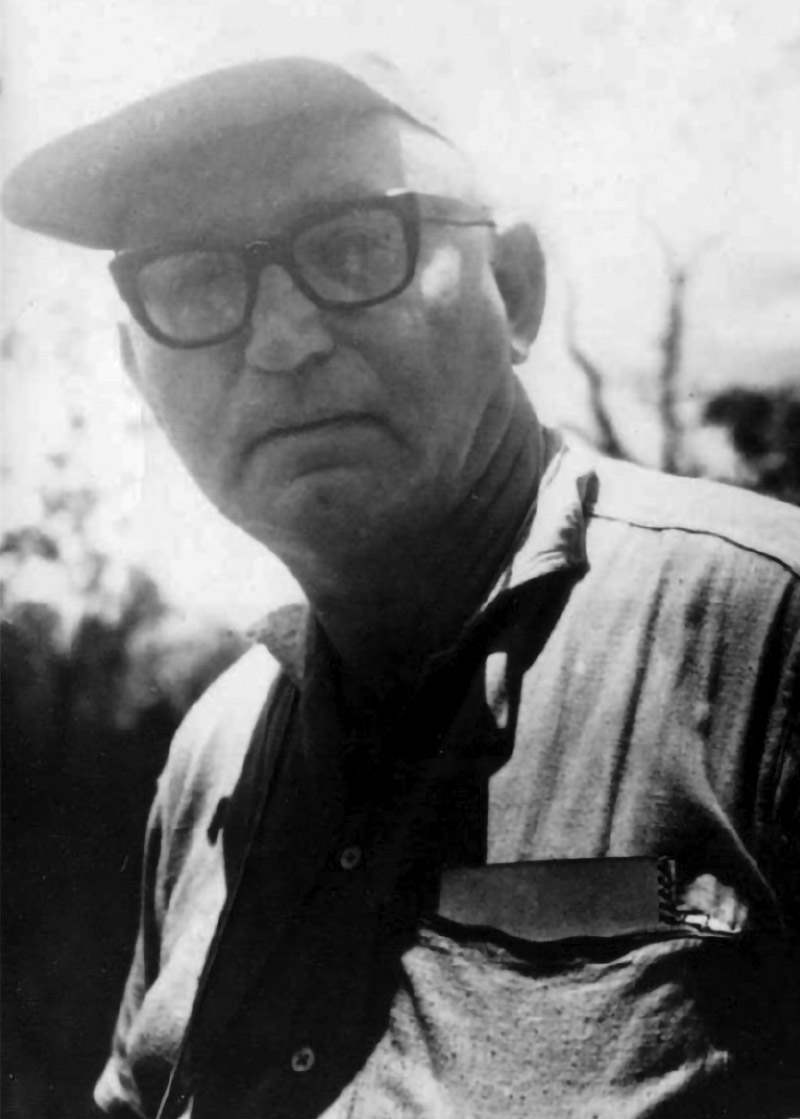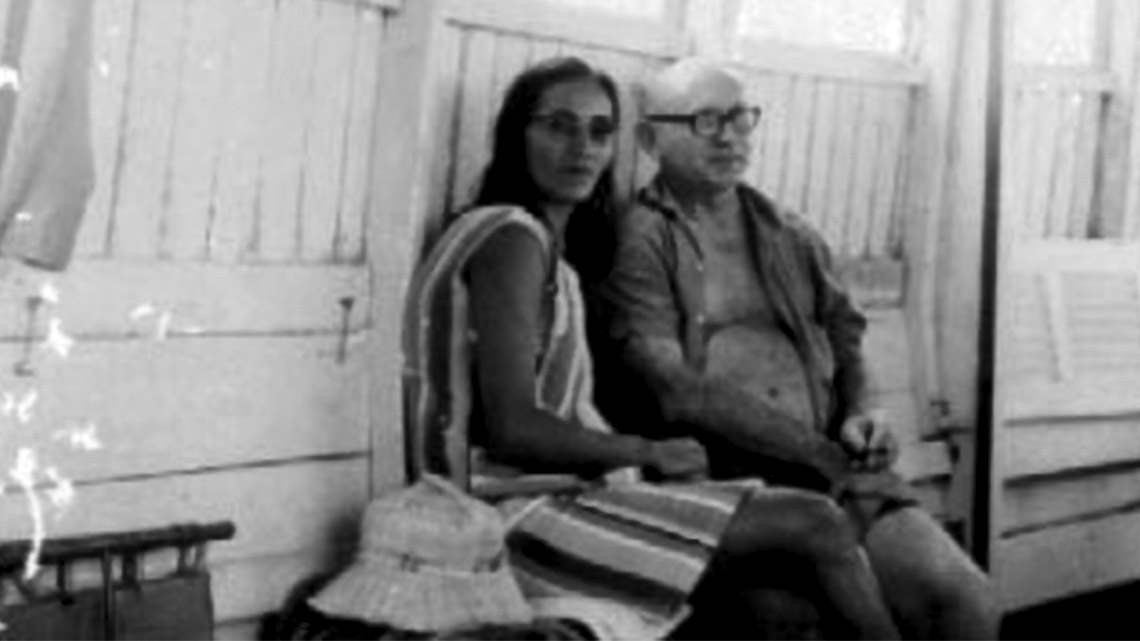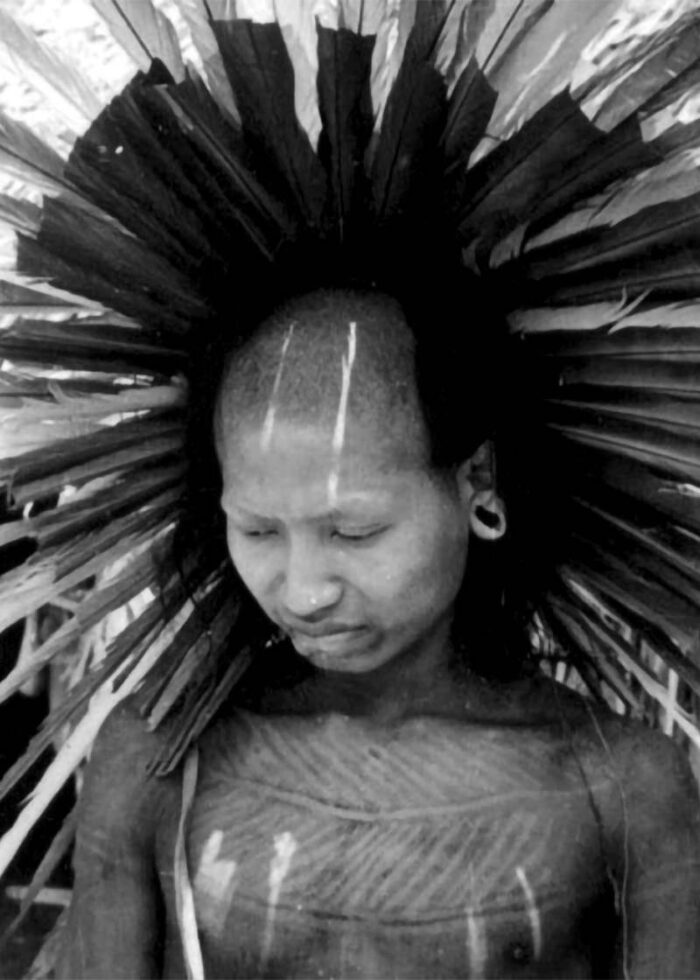“Take a look!” Archaeologist Edithe Pereira was visibly excited to show her colleague, Cristiana Barreto, and historian of science Nelson Sanjad what was inside the five boxes she had just opened in her office at the Emílio Goeldi Museum of Pará (MPEG), in Belém, in early February 2019. The boxes contained journals, field notes, typewritten draft articles, maps, and detailed descriptions of some 150 petroglyphs at 35 archaeological sites that Franciscan missionary and anthropologist Günther Protásio Frikel (1912–1974) had researched during his travels through the Amazon. The boxes had been kept in storage for around 50 years. Pereira had searched for this “treasure”, as she called it, for almost 20 years since receiving from her colleague at the museum around 400 photos of rock carvings taken by Frikel himself using a Rolleiflex camera. “I knew there’d be more data out there because he was known to be meticulous and would not have contented himself with just taking photos,” she says.
As anthropologist Beatrix Hoffmann, from the University of Bonn, Germany, transcribes the diaries—all written in Old German—Pereira has had the typewritten texts translated and has digitized the photos, negatives, and documentation depicting the different petroglyph sites, as part of a research grant from the Brazilian National Council for Scientific and Technological Development (CNPq). She plans to publish a book with her findings in 2022. “Virtually no one knows about this material, a considerable addition to the collection of known petroglyphs in the Amazon,” she says. The petroglyphs shown in the photos were either engraved or embossed in rocks along riverbanks, depicting highly elaborate and nearly always symmetric figures and geometric designs.
In the early 1990s, Pereira ventured down the river Erepecuru, in the municipality of Oriximiná, Northwestern Pará, but was unable to get past the first few waterfalls. She never found the petroglyphs Frikel had described in the region 60 years prior, but did find a still undocumented petroglyph on the island of Descanso. Who the creators of the rock art were remains unknown; neither the quilombolas in the region nor the Zoé, a local indigenous group, have recognized the artifacts as being their own, suggesting they may have been crafted by Brazil’s earliest inhabitants. Rock paintings and engravings found at archaeological sites near Santarém, northern Pará, which Pereira describes in her book, Arte rupestre de Monte Alegre – Pará, Amazônia, Brasil (Amazon rock art in Monte Alegre – Pará, Brazil; Museu Goeldi, 2012), date back to approximately 12,000 years ago.
“Frikel is known primarily for his discovery of the first riverside shell mound—a deposit of shells, bones, and other materials left by pre-Columbian peoples—in the Amazon in 1939, and for his archaeological research in the 1960s in the Tumucumaque Uplands of Pará, which he reached after a three-month expedition down the Erepecuru, a river dotted with waterfalls,” she says. He would travel these distances to conduct Catholic rites such as masses, baptisms, weddings, and funerals among the peoples of the region, whose habits he observed and described in detail. “Frikel’s work in the Tumucumaque Uplands was for many years the only source of reference on archeology in the region,” notes Pereira. Two other German researchers were also studying indigenous peoples in Brazil around that time, ethnologist Curt Nimuendajú (born Curt Unckel, 1883–1945) and anthropologist Herbert Baldus (1899–1970), who traveled through the country’s Southeast, South, and Midwest regions. Like his fellow countrymen, Frikel’s work was recognized internationally; he published in German, but was a member of scientific societies across Europe, not just in Germany.
Lucia Hussak van Velthem, an anthropologist at the Goeldi Museum, notes that Frikel “took a holistic approach to his work, examining all aspects of indigenous culture,” in line with the principles laid down by Polish anthropologist Bronislaw Malinowski (1884–1942) and German anthropologist Franz Boas (1858–1942). “He visited virtually all of the remote and difficult-to-access indigenous villages in northern Pará,” she says. Velthem is researching another unexplored part of his collection: the diaries in German of his field trips to Aparai and Wayana villages in northern Pará, which Frikel’s widow, Marlene, provided along with the petroglyph photos she gave to Pereira. In 2019, anthropologist Ruth Cortez, widow of fellow anthropologist Roberto Cortez (1940–2013), who worked with Frikel in Tumucumaque, gave her boxes with additional material for her research.
After graduating in museology, Velthem went on to work at the Goeldi Museum in 1973 on a CNPq grant, with Frikel agreeing to be her advisor as he had already done extensive research in anthropology a was by then an official researcher at the Museum of Belém. Frikel, Marlene, and Velthem made two field trips together. In the first, which lasted two months, in 1973, they studied the Mundurucu, an indigenous group with around 3,000 members living along the Cururu River, in southwestern Pará (today they number around 11,000). Velthem researched the methods used to make the baskets in which indigenous women carried firewood and cassava, while Frikel studied their systems of kinship and social organization. The following year, during a four-month field trip, they visited each of the Mundurucu villages in the region as well as their “sacred grounds, in a completely isolated spot with a 30-meter-high waterfall and a large pond,” she recalls. “Frikel died suddenly a few months after this trip. He had blue eyes, was tall, fat, and very stern. He could be very kind but also very harsh. He was an excellent teacher, who showed how important it was to have all your senses tuned in when doing field research among indigenous peoples.”
A priest turned researcher
Born in Wroclaw, then a German city (before becoming a part of Poland in 1945), the son of a watchmaker, Frikel went to Recife, Pernambuco, northeastern Brazil, in 1931 to study philosophy under Franciscan priests, who gave him a new middle name, Protásio, by which he became better known. Three years later he moved to a seminary in Salvador, Bahia, to study theology. Drawn by his interest in ethnology, he researched the Jege-Nago arm of Bahian Candomblé and published his observations in a 1941 article in German in the journal Revista dos Franciscanos.
After becoming a priest in 1938, Frikel went to Santarém and began his missionary work there. A self-taught archaeologist and anthropologist, he also began doing research informally, collecting material and information and documenting his observations. From 1939 to 1941, he collected 175 ceramic shards and artifacts from the surface of the Ponta do Jauari shell mound, west of Alenquer, Pará, and sent the material along with notes to his friend Peter Hilbert (1914–1989), an archaeologist at the Goeldi Museum. In a 22-page booklet published by the Pará Institute of Anthropology and Ethnology in 1959, Hilbert noted that these objects bore similarities with the oldest phase (980 to 200 BC) of the Marajoara ceramics found on the Island of Marajó, around 600 kilometers away. “Frikel said he was not an archaeologist, but he was known for doing archaeological research using a very meticulous and unbiased approach at a time when there was no data available on this area of the Amazon,” says Pereira.
He also studied the ways of life of maroon communities along the Trombetas, Curuá, and Cuminá rivers, in Pará, and made contact with the Kaxuyana, Parukotó, Wayana, Aparaí, and Tiriyó. After gaining Brazilian citizenship in 1963, he started working as an anthropologist at the Goeldi Museum and was later appointed as alternate director of the Anthropology Section. “His interests in anthropology soon outweighed his religious vocation,” says Velthem. To devote himself entirely to research, he left the Franciscan order and later married Marlene, who became his companion on his frequent field trips.
In a 1975 article in the journal Indiana, German anthropologist Hans Becher (1918–?) wrote that Frikel’s “most notable work” was on the social organization, traditions, and cultural shifts among the Tiriyó: “From 1950 to 1974 he undertook a total of 14 trips to [visit] these Indians [sic].” His research led to the creation of the Tumucumaque National Park, in 1968. In a 117-page book published by the Goeldi Museum in 1971, titled Dez anos de aculturação Tiriyó 1960-70 (Ten years of acculturation of the Tiriyó 1960-70), Frikel noted how a religious mission in the Tiriyó territory had a sawmill, a pottery shop, a tractor, sewing machines, cattle and poultry, a cream separator for making butter, refrigerators, and electric saws. “Rather than rejecting this modern machinery, they [the Tiriyó], after seeing how it worked, became enthusiastic, really interested,” he observed.
These indigenous communities already used knives and axes, iron pans, shotguns, flashlights, radios, pants and shirts (men), and dresses and skirts (women), although they did not wear them all the time. “They no longer hold their traditional hunting parties; they no longer dance, not even for entertainment at night; they no longer sing their songs at parties, when drinking, etc.; they no longer tell their legends; they no longer talk about their shamans and their deeds, the spirit world and their ancestors, because all of them—spirits, shamans, and ancestors—are now in that “great fire” that is hell, for not having known and observed Scripture,” he noted.
Frikel criticized this method of evangelization. He believed that “no mission has the right to detach the Indian [sic] from his traditions” and that Christianity “should supplement ancient beliefs” rather than supplant the ways of life of indigenous peoples. Currently, around 1,000 Tiriyó live in northern Pará and another 1,200 in Suriname. Living near them, in Tumucumaque, are the Katxuyana, a group of about 450 people inhabiting northwestern Pará, whom Frikel also studied. “Frikel’s work has been crucial in recovering the heritage of Amazon peoples,” says Velthem.
He also collected items for museums in Austria, Germany, Denmark, and Sweden. “These were newly made objects that indigenous people sold or traded with researchers,” explains Velthem. The Goeldi Museum has boxes with around 50,000 specimens of pottery, stone instruments, shells, and bones that Frikel collected on his expeditions to Pará and Amazonas, grouped into six collections. In 2006, Pereira and historian Vitor Martins, currently at Pará State University, opened the boxes to inventory Frikel’s collections, and found that more than 90% of the archaeological material had not yet been analyzed. “Nobody had taken an interest in these materials,” says Pereira, “but now, Frikel’s archaeological collection has been analyzed and is available for research.”
Republish